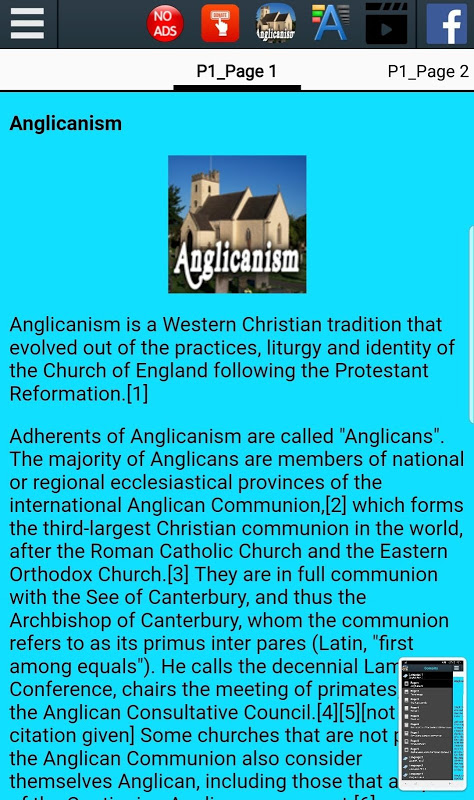Advertisement
Latest Version (Download)Table of Contents
Advertisement
Information
| Package | com.historyisfun.anglican |
| Version | 1.3 |
| Date Updated | 2020-06-11 |
| Size | 4.41 MB |
| Installs | 2 |
| Categories | , |
Screenshots
Description
History of the Anglicanism
Anglicanism is a Western Christian tradition that evolved out of the practices, liturgy and identity of the Church of England following the Protestant Reformation.[1]
Adherents of Anglicanism are called "Anglicans". The majority of Anglicans are members of national or regional ecclesiastical provinces of the international Anglican Communion,[2] which forms the third-largest Christian communion in the world, after the Roman Catholic Church and the Eastern Orthodox Church.[3] They are in full communion with the See of Canterbury, and thus the Archbishop of Canterbury, whom the communion refers to as its primus inter pares (Latin, "first among equals"). He calls the decennial Lambeth Conference, chairs the meeting of primates, and the Anglican Consultative Council.[4][5][not in citation given] Some churches that are not part of the Anglican Communion also consider themselves Anglican, including those that are part of the Continuing Anglican movement.[6]
Anglicans base their Christian faith on the Bible, traditions of the apostolic Church, apostolic succession ("historic episcopate"), and writings of the Church Fathers.[1] Anglicanism forms one of the branches of Western Christianity, having definitively declared its independence from the Holy See at the time of the Elizabethan Religious Settlement.[7] Many of the new Anglican formularies of the mid-16th century corresponded closely to those of contemporary Protestantism. These reforms in the Church of England were understood by one of those most responsible for them, Thomas Cranmer, the Archbishop of Canterbury, as navigating a middle way between two of the emerging Protestant traditions, namely Lutheranism and Calvinism.[8] By the end of the century, the retention in Anglicanism of many traditional liturgical forms and of the episcopate was already seen as unacceptable by those promoting the most developed Protestant principles.
In the first half of the 17th century, the Church of England and its associated Church of Ireland were presented by some Anglican divines as comprising a distinct Christian tradition, with theologies, structures, and forms of worship representing a different kind of middle way, or via media, between Protestantism and Roman Catholicism – a perspective that came to be highly influential in later theories of Anglican identity and expressed in the description of Anglicanism as "Catholic and Reformed".[9] The degree of distinction between Protestant and Catholic tendencies within the Anglican tradition is routinely a matter of debate both within specific Anglican churches and throughout the Anglican Communion. Unique to Anglicanism is the Book of Common Prayer, the collection of services that worshippers in most Anglican churches have used for centuries, and is thus acknowledged as one of the ties that bind the Anglican Communion together.
After the American Revolution, Anglican congregations in the United States and British North America (which would later form the basis for the modern country of Canada) were each reconstituted into autonomous churches with their own bishops and self-governing structures; these were known as the American Episcopal Church and the Church of England in the Dominion of Canada. Through the expansion of the British Empire and the activity of Christian missions, this model was adopted as the model for many newly formed churches, especially in Africa, Australasia, and Asia-Pacific. In the 19th century, the term Anglicanism was coined to describe the common religious tradition of these churches; as also that of the Scottish Episcopal Church, which, though originating earlier within the Church of Scotland, had come to be recognised as sharing this common identity.
What's New
Latest Version (Download)
History of the Anglicanism 1.3Date Updated : 2020-06-11
Advertisement






